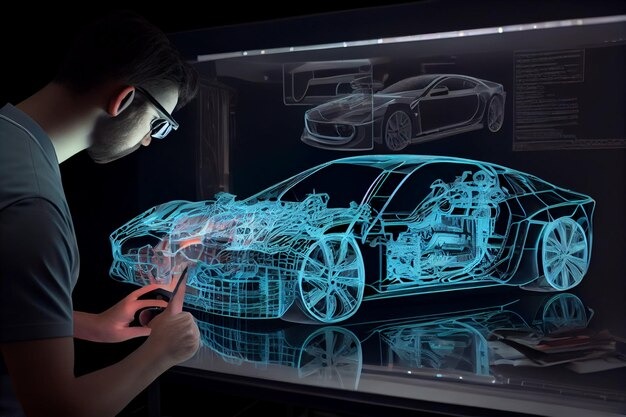The automotive industry specifically requires detailed design and engineering to manufacture new models of vehicles. Computer-aided design or CAD is another very crucial tool that is used in translating vehicle designs from conception to reality. For instance, 3D CAD models and simulations are used extensively in the automotive design lifecycle.
This blog post focuses on the use of 3D CAD in automobile design and development processes such as designing parts, simulation, drafting drawings, and costing. It defines some of the advantages of using 3D CAD in engineering over traditional 2D drafting to produce better results.
Designing Drafting Automotive Components with 3D CAD
The primary application of 3D CAD in the automotive industry is in the creation of part models and assembly models. It is used by designers to model and analyze part and assembly designs in three dimensions before proceeding to build prototypes and conduct tests.
Parametric Designing and Drafting allow engineers to easily change design factors such as size, form, and relative position of parts. This helps in comparing different designs and design variations and iterations than hand drafting methods. Interference and clash detection between the components to be mounted in a cramped space is also another area in which engineers apply CAD.
Namely, 3D CAD is a tool that helps engineers evaluate and analyze designs and identify potential problems before proceeding to the creation of physical prototypes, thus saving time and money. Accurate CAD models also help in ensuring that parts fit well and can be assembled properly during production.
Leveraging 2D to 3D CAD Conversion Service
Though new automotive projects employ 3D CAD to a larger extent, the OEMs occasionally have to transfer their 2D To 3D CAD Conversion Services platforms when updating technologies or introducing new models based on prior platforms. Blessed with expertise, specialized CAD conversion services also economically assist in this migration process.
Through the automated and manual conversion method, the service providers can convert the present 2D drawings, sketches, drafts, and files into advanced smart and editable 3D CAD models. This allows automakers to reuse and transfer design data from one generation of a product to another while at the same time benefiting from new design, engineering, and manufacturing disciplines.
Performing Simulations for Design Validation
The 3D CAD environment is the starting point for performing vital performance assessments by using CAE tools and applications. Civil and mechanical engineers perform finite element analysis to predict stress, strain, deformation, vibration, and fatigue behavior with accurate 3D part models from computer-aided design.
Airflow simulation aids in the study of the movement of air over the external body surfaces of vehicles. Thermal analysis involves the study of heat transfer and heat rejection across various parts of the engine. Designers also use virtual crash test dummies to assess ergonomics and human factors as well.
Conducting realistic physics-based simulations in the design phase enhances the possibility of uncovering any difficulties power before going for costly physical tests and prototyping processes. This helps to prevent expensive revisions in the future.
Cost Estimators for Concept Modeling
One practical use of 3D CAD in automobiles is creating full-size wooden or foam-framed concept car mock-ups. Often called clay or tape drawings, scaled wooden frames that correspond to the size of the planned car are handmade by modeling masters based on the conceived impressions.
These physical models are then covered with a layer of modeling clay or foam to assess the overall form, proportions, and styling before going into the actual engineering of the automobile. Other times, Wood Framing Cost Estimators employ cost estimator tools in establishing framing construction costs for the budget concept modeling of projects.
Thus, although it is not highly accurate for fine engineering, using conceptual 3D modeling with CAD-generated wood buck framing offers a clear and accurate understanding of possible production intent design.
Generating Technical Drawings
One of the most important items of 3D CAD data is the generation of accurate 2D technical drawings for manufacture. The solid geometry in the CAD software can instantly generate different production-ready drawings from its 3D models like component drawings, assembly plans, blueprints with different projections, and many more.
3D models are easily associated with subsequent manufacturing drawings, which allows for all design requirements and BOMs to be reflected in the actual construction process. It does away with paperwork passing through different departments and minimizes the mistakes that may be caused by working on an old document.
When the 3D CAD is updated it automatically updates all the associated drawings thus eliminating the need for massive manual drafting. This automation helps in making quick design changes where it is required and helps in getting to the manufacturing stage quicker.
Conclusion
A new generation of actual 3D CAD systems has significantly contributed to new automotive design innovations, higher performance, and less development time and costs. Implementing such virtual 3D models and utilization in the designs, simulations, drafting, and costing bring better engineering outlook, efficiency, and accuracy than traditional 2D modeling.
The continued growth of 3D CAD in automotive engineering is evident due to its effectiveness in handling complex parts, assemblies, and flexible designs as well as being linked with lower production processes. The survey finds that with the rising implementation of new technologies such as additive manufacturing, generative design, and virtual reality/augmented reality, 3D CAD will be fundamental to the next-generation automotive product creation.
